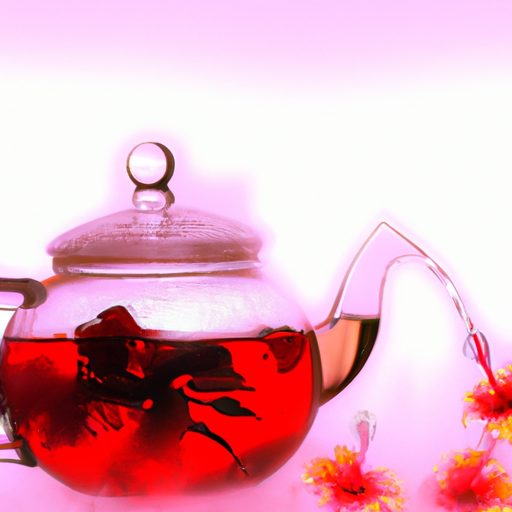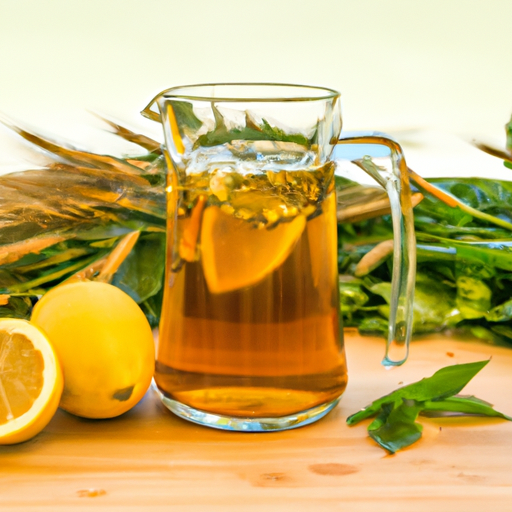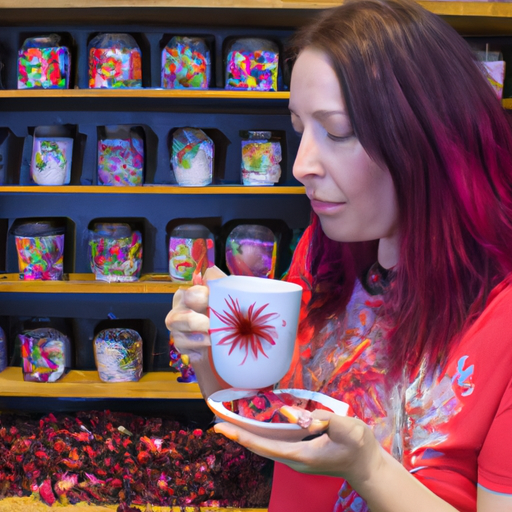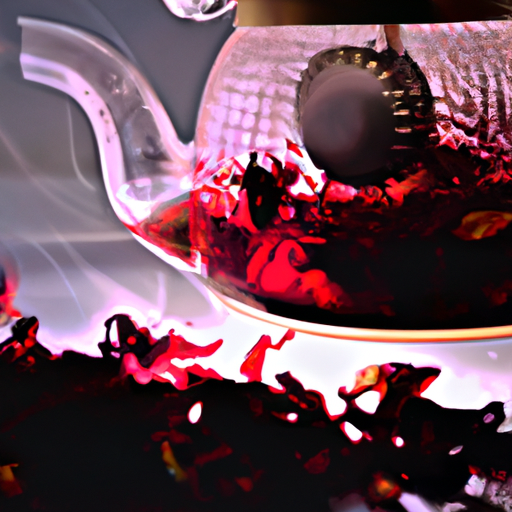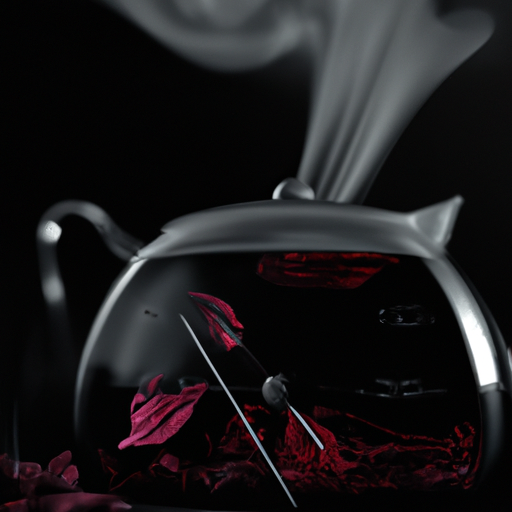Hello tea enthusiasts! I’m thrilled today to impart my wisdom on how to make the ultimate cup of hibiscus tea.
Hibiscus tea is not only delicious, but it’s also packed with health benefits. This vibrant and tart-tasting tea is made from the dried petals of the hibiscus flower, which is known for its high levels of vitamin C, antioxidants, and anti-inflammatory properties.
To brew a cup of hibiscus tea that’s bursting with flavor and nutrients, you need to start by selecting the right type of leaves. Whether you prefer loose leaf or bagged tea, make sure to choose organic hibiscus leaves that are dark red in color and free from any added flavors or colors.
Once you have your leaves ready, it’s time to prepare your equipment and get ready to brew! Follow these simple steps for a perfect cup every time.
Key Takeaways
- Hibiscus tea is made from dried petals of the hibiscus flower and is high in vitamin C, antioxidants, and anti-inflammatory properties.
- Brewing hibiscus tea requires tea equipment such as a kettle, pot, tea strainer, and teapot, and the ideal water temperature is 195-205°F (90-96°C).
- Enhancing the flavor of hibiscus tea can be done by adding ginger, mint leaves, honey, or agave nectar, and experimentation with different flavors is encouraged.
- Hibiscus tea has numerous health benefits, including improving heart health, boosting immunity, aiding digestion, and reducing blood pressure and cholesterol levels.
Choosing the Right Hibiscus Tea Leaves
Selecting the appropriate hibiscus tea leaves is paramount in achieving a delectable brew. Not all hibiscus plants are created equal, and it’s vital to choose the right variety for your tea.
The most common type of hibiscus used for tea is Hibiscus sabdariffa, which has a tart and tangy flavor profile that’s perfect for brewing. Aside from its delicious taste, hibiscus tea benefits are plentiful. It’s loaded with antioxidants that can help reduce inflammation and improve heart health. Plus, it’s caffeine-free, making it an excellent alternative to coffee or black tea if you’re looking for something less stimulating.
When selecting your hibiscus tea leaves, keep in mind that the quality of the leaves can significantly impact the flavor of your final brew. Choose leaves that have a deep red color and are free from any blemishes or discoloration. It’s also essential to purchase from a reputable source to ensure that you’re getting high-quality, organic leaves.
Now that you’ve selected your perfect hibiscus tea leaves, let’s move on to preparing your equipment so we can start brewing!
Preparing Your Tea Equipment
Before I start brewing my hibiscus tea, it’s important to make sure my tea equipment is prepared and ready.
First, I fill up my tea kettle or pot with cold water and bring it to a boil.
Then, I grab my trusty tea strainer to ensure that no loose leaves end up in my cup of tea.
Finally, I get out my teapot so that the brewed tea can steep properly before pouring into a cup.
It’s crucial to have all of these items on hand for a successful cup of hibiscus tea.
Tea Kettle or Pot
First, grab your trusty tea kettle or pot and fill it up with fresh, cold water. When choosing between a tea kettle and teapot, consider that a tea kettle is typically used on the stovetop to heat water for multiple cups of tea at once. A teapot, on the other hand, is used to steep tea leaves in already heated water. Additionally, there are stovetop kettles and electric kettles available on the market. Stovetop kettles require direct heat from a stove burner while electric kettles use electricity to heat up the water. Make sure to choose the option that suits your needs best.
When filling up your tea kettle or pot with water, ensure that you have enough for all the cups of tea you plan on brewing. It’s also important to note that different types of teas require different temperatures of water for optimal brewing results.
Green and white teas should be brewed with cooler temperature water around 175-185°F (79-85°C) while black and herbal teas can withstand hotter temperatures around 208-212°F (98-100°C). Keep this in mind when selecting your method of heating up your water and adjusting the temperature accordingly.
Now that we have our hot water ready, let’s move onto the next step – using a tea strainer to brew our hibiscus tea.
Tea Strainer
Once the water is heated to the desired temperature, simply place the tea strainer filled with hibiscus flowers into your cup and pour the hot water over it. A tea strainer is an essential tool for brewing loose-leaf teas like hibiscus. It helps to filter out any leaves or petals that may escape during steeping, resulting in a clean and enjoyable cup of tea.
When using a tea strainer, there are a few brewing techniques to keep in mind. Firstly, make sure that the strainer fits comfortably in your cup or mug. Secondly, adjust the amount of hibiscus you use based on how strong you prefer your tea. Lastly, be mindful of how long you steep your hibiscus flowers for optimal flavor extraction. The table below summarizes these guidelines for easy reference.
| Brewing Technique | Method |
|---|---|
| Tea Strainer Size | Ensure it fits comfortably in your cup/mug |
| Amount of Hibiscus | Adjust based on personal preference |
| Steeping Time | 5-7 minutes for optimal flavor extraction |
Moving onto using a teapot can also provide convenience when brewing larger quantities of hibiscus tea without sacrificing taste.
Teapot
Using a teapot is a great option for those who want to brew larger quantities of hibiscus tea. When choosing the perfect teapot, it’s important to consider the material it’s made of and its size.
Ceramic or porcelain teapots are excellent choices as they retain heat well and don’t affect the taste of the tea. Glass teapots are also popular as they allow you to watch the brewing process unfold.
The size of your teapot will depend on how much tea you plan on making, but it’s recommended to choose one that can hold at least twice as much water as you need for your desired amount of tea.
After using your teapot, it’s essential to clean it thoroughly to prevent any buildup and ensure that each brew yields delicious results. To clean your teapot, rinse with hot water and use a soft brush or cloth to remove any residue or stains.
If stubborn stains persist, fill your pot with equal parts water and white vinegar and let it sit for several hours before rinsing thoroughly with hot water. Once cleaned, your teapot will be ready for its next use in creating a delicious hibiscus tea brew.
Now that we’ve chosen our perfect teapot and ensured its cleanliness, we’re ready for the next step – boiling the water!
Boiling the Water
Before I start boiling water for my hibiscus tea, I make sure to pay attention to three important factors: temperature, quantity, and quality.
First, the ideal water temperature for brewing hibiscus tea is around 195-205°F (90-96°C). This ensures that the tea will steep properly without becoming too bitter or too weak.
Second, it’s important to measure out the right amount of water for your tea leaves or bags – usually about 8 ounces per cup of tea.
Finally, using high-quality filtered or spring water will help ensure the best flavor and avoid any unwanted minerals or contaminants in your brew.
By carefully considering these factors when boiling my water, I can be confident that my hibiscus tea will turn out perfectly every time.
Water Temperature
To get the perfect cup of hibiscus tea, you’ll want to make sure your water is at the right temperature. The ideal water temperature for brewing hibiscus tea is around 200°F, which is just below boiling point.
If your water is too hot, it can scorch the delicate petals and leave a bitter taste in your tea. On the other hand, if the water is not hot enough, it won’t draw out all of the flavors and nutrients from the petals.
To achieve this optimal temperature for hibiscus tea brewing, you can let your kettle come to a boil and then allow it to cool down for 30 seconds or so before pouring it over your tea leaves or teabag. Alternatively, you can bring your water up to around 200°F using a thermometer or by simply watching for small bubbles forming on the bottom of your pot.
Once you have reached this sweet spot of water temperature, steeping time becomes critical in unlocking all those delicious flavors!
When it comes to quantity, there are some guidelines that’ll be helpful when making a great cup of hibiscus tea…
Quantity
Achieving the perfect cup of hibiscus tea requires careful consideration of how much you add to your infuser or pot. The quantity of hibiscus flowers used for brewing can have a significant impact on the flavor and health benefits of your tea. Here are some brewing tips that will help you make the most out of your hibiscus flowers:
Firstly, it is best practice to use around 1-2 tablespoons (or 5-10 grams) of dried hibiscus flowers per 8 ounces (or 240 ml) of water. This ratio may vary depending on personal preference, but using more than this may result in an over-extracted and unpleasant tasting tea. Secondly, if you are using fresh flowers instead, it is recommended to double the amount as compared to dried ones. Lastly, always remember to use filtered or clean water for brewing as impurities in tap water may alter the taste and quality of your tea. Apart from tasting great, hibiscus tea also offers numerous health benefits such as improving heart health and reducing inflammation.
With the right quantity of hibiscus flowers added into your brew, it’s time to move onto the next step – ensuring high-quality ingredients for optimal results!
Quality
When it comes to quality, I always make sure to source the best hibiscus flowers for my tea. The benefits of drinking hibiscus tea are numerous, and using high-quality ingredients ensures that you’re getting the most out of each cup.
Look for hibiscus flowers that are bright red or deep magenta in color, as this is a sign of freshness and potency. Sourcing your hibiscus from a reputable supplier is also important when it comes to quality. Make sure the flowers are free from pesticides and other harmful chemicals by choosing organic options whenever possible.
By taking these steps to ensure quality, you’ll be able to enjoy all of the health benefits that come with drinking hibiscus tea.
Moving on to steeping the tea…
Steeping the Tea
Now that the water’s been boiled, it’s time to steep our hibiscus tea.
The amount of time required for steeping will depend on personal preference and desired strength of the tea.
Generally, a ratio of 1 tablespoon of loose leaf hibiscus tea per 8 ounces of water is recommended, and an infusion time of 5-10 minutes is ideal for a flavorful cup.
Time Required
Brewing a delicious cup of hibiscus tea only takes a few minutes, making it the perfect quick and easy beverage for any time of day. To ensure that you get the best flavor and benefits from your tea, it’s important to steep it for the right amount of time. Here are some things to keep in mind when steeping hibiscus tea:
- Hibiscus tea should be steeped for 5-10 minutes.
- Steeping the tea for too long can make it bitter.
- If you want a stronger flavor, use more tea leaves instead of steeping longer.
When brewing hibiscus tea, timing is everything. Steep it for too little time and you won’t get all of its health benefits; too long and you’ll end up with a bitter cup.
Now that we know how long to steep our tea, let’s move on to discussing the water-to-tea ratio.
Water to Tea Ratio
To get the perfect cup of this refreshing hibiscus tea, you’ll want to make sure you’re using the correct water-to-tea ratio. The ratio is crucial because it determines the tea strength and ultimately affects your overall enjoyment of the beverage.
When brewing hibiscus tea, it’s recommended to use one tablespoon of dried hibiscus flowers for every 8 ounces of boiling water. If you prefer a stronger brew, increase the amount of tea used accordingly. Keep in mind that too much hibiscus can result in an overly tart flavor profile, so it’s best to experiment with small adjustments until you find your preferred strength.
Once you’ve determined your ideal ratio, let the mixture steep for about 5-10 minutes before straining out the flowers and enjoying your perfectly brewed cup of hibiscus tea. Now that we know how to measure our water-to-tea ratio for optimal taste, let’s move on to discussing infusion duration or how long we should let our tea steep for maximum flavor extraction.
Infusion Time
Once the hibiscus flowers have been steeped in boiling water, it’s crucial to let them sit for a specific amount of time to ensure maximum flavor extraction. The infusion time will vary based on personal preference and the desired strength of the tea.
As a general rule, the longer you steep the flowers, the stronger and more tart the flavor will be. For a mild hibiscus tea, an infusion time of 5-7 minutes is recommended. This allows for enough time for the flavors to develop without becoming too overpowering. For those who prefer a stronger tea with more bite, an infusion time of 10-15 minutes may be more suitable.
It’s important to note that over-steeping can lead to bitterness and a less pleasant taste overall. Adjusting taste is also possible by experimenting with different infusion times until reaching your preferred flavor profile. Besides its delicious taste, hibiscus tea has many health benefits such as being high in vitamin C and antioxidants, aiding digestion and reducing blood pressure levels.
Once you’ve reached your desired level of infusing hibiscus flowers, it’s now possible to move on adding flavors to your tea without sacrificing any of its natural qualities.
Adding Flavor to Your Tea
If you’re looking to add some extra flavor to your hibiscus tea, try infusing fruits, spices, or herbs. One popular choice is ginger, which adds a spicy kick and has anti-inflammatory properties.
Mint leaves can give a refreshing taste while also aiding digestion. For a sweeter option, try adding honey or agave nectar instead of traditional sugar. Experimenting with sweeteners is another way to enhance the flavor of your hibiscus tea.
Stevia is a natural sweetener that won’t spike blood sugar levels and has zero calories. It’s also a great option for those who are watching their weight or have diabetes. Another alternative is using fruit juice like pineapple or apple instead of sugar for added sweetness without any artificial ingredients.
When it comes to serving and presentation, you can get creative by adding garnishes such as edible flowers or pieces of fruit on top of your tea cup. You can also serve the tea over ice for a refreshing summer drink. With all these options for customizing your hibiscus tea, there’s no excuse not to enjoy this delicious and healthy beverage!
Serving and Presentation
Get creative with how you present and serve your flavorful cup of hibiscus tea, adding edible flowers or fruit slices as garnishes for an extra touch of elegance. Setting a beautiful table can make the experience even more enjoyable. Consider using a floral tablecloth or placemats to complement the tea’s natural coloring. When it comes to serving, opt for delicate teacups and saucers that showcase the tea’s vibrant hue.
To take your presentation up a notch, try incorporating some garnishing techniques. Use fresh mint leaves to add a pop of greenery to your cup or sprinkle some cinnamon on top for a warm and spicy flavor. You could also freeze small berries inside ice cubes for an eye-catching addition that will keep your drink cool without diluting its taste.
When it comes to serving hibiscus tea, details matter. The right table setting and garnishes can elevate even the simplest cup into something truly special. In the next section, we’ll explore how best to store your brewed tea so that it stays fresh and delicious over time.
Storing Your Hibiscus Tea
To keep your hibiscus tea fresh and flavorful, it’s essential to store it properly. Storing tips include keeping the tea in an airtight container in a cool, dry place away from direct sunlight. This helps preserve the taste, aroma, and color of the tea.
The shelf life of hibiscus tea depends on various factors such as the storage conditions and whether or not it contains any additives such as sugar or honey. Generally speaking, hibiscus tea can last up to six months if stored correctly. However, adding sweeteners may reduce its shelf life by promoting bacterial growth.
Storing your hibiscus tea correctly is crucial for ensuring its freshness and longevity. By following these simple storing tips and being mindful of the shelf life of your tea, you can enjoy a delicious cup of hibiscus tea for months to come.
Now let’s move on to explore some exciting variations of this delightful beverage!
Variations of Hibiscus Tea
As I’m exploring the world of hibiscus tea, let’s recap what we’ve learned so far. We know how to brew and store our tea for maximum flavor and freshness.
Now, let’s talk about some tips for enjoying your tea. You can add honey or lemon for added sweetness and tartness. There are also plenty of resources available online for finding new variations of hibiscus tea recipes and learning more about this delicious beverage.
Recap
Let’s quickly review what we’ve learned so far about brewing hibiscus tea. In our previous subtopic, we discussed the variations of hibiscus tea, including its different flavors and blends. Now, let’s take a closer look at the health benefits and flavor profile of this refreshing drink.
Benefits overview:
- Hibiscus tea is rich in antioxidants that help protect against cell damage.
- It may help lower blood pressure and cholesterol levels.
- Drinking hibiscus tea regularly can improve liver health.
Health benefits:
- Hibiscus tea has anti-inflammatory properties that can reduce inflammation in the body.
- It is also known to have antibacterial effects that can boost immunity.
- Regular consumption of hibiscus tea may aid in weight loss.
Flavor profile:
- Hibiscus tea has a tangy and tart taste with floral notes.
- The color ranges from deep red to pink depending on the amount of steeping time.
- The addition of sweeteners or other herbs can enhance its flavor further.
Now that we have an overview of the benefits and flavor profile of hibiscus tea, let’s move on to tips for enjoying your cuppa without compromising its quality.
Tips for Enjoying Your Tea
Savoring your cup of hibiscus infusion requires simple techniques, such as steeping it at the right temperature and adding a touch of honey or lemon for an extra kick. To get the best flavor, use water that is just below boiling point, around 190°F. Steep the tea for about five minutes to ensure that you get all the health benefits and flavors from the leaves.
When it comes to pairing suggestions, hibiscus tea goes well with light snacks like fresh fruits or crackers. For a more substantial meal, try pairing it with grilled fish or chicken. Not only does this make for a delicious meal, but it also enhances the health benefits of hibiscus tea which include reducing blood pressure and cholesterol levels. So go ahead and experiment with different pairings to find out what works best for you!
Looking for additional resources on brewing your own hibiscus infusion? Check out our next section where we’ll provide you with some helpful tips and tricks!
Additional Resources
Now that you’ve learned some tips for enjoying your hibiscus tea, let’s delve deeper into the world of this vibrant beverage.
There are many additional resources available to expand your knowledge and appreciation of hibiscus tea.
Firstly, it’s important to note the health benefits associated with hibiscus tea. This tangy and refreshing drink is packed full of antioxidants which work hard to reduce inflammation in the body, lower blood pressure, and improve liver function. Additionally, hibiscus tea has been known to boost immunity and aid digestion.
Secondly, hibiscus tea holds cultural significance in many parts of the world. It is a staple in Caribbean cuisine where it is consumed as a hot or cold beverage with meals or enjoyed on its own as a refreshing thirst quencher. In Egypt, it is considered an integral part of daily life where it is often consumed after meals as a digestive aid. And in Mexico, it holds cultural significance during Dia de los Muertos celebrations where it is brewed into a festive punch called ‘ponche’.
With so much history surrounding this delightful beverage, there’s no shortage of information out there waiting to be explored!
Check out online forums dedicated to all things tea-related.
Explore local specialty shops for unique blends and brewing accessories.
Experiment with adding different flavors such as mint or ginger for added complexity.
By taking advantage of these additional resources, you’ll gain valuable insights into the rich history and health benefits associated with hibiscus tea while simultaneously expanding your palate through experimentation with unique flavor combinations.
Frequently Asked Questions
What are some potential health benefits of drinking hibiscus tea?
Health benefits of drinking hibiscus tea have been supported by scientific evidence. Research has shown that it can help lower high blood pressure, reduce cholesterol levels, and improve heart health.
Additionally, the antioxidants in hibiscus tea may help to protect against cell damage and prevent chronic diseases such as cancer.
Different varieties of hibiscus tea offer unique flavor profiles ranging from sweet to tart, making it a versatile beverage choice.
Overall, incorporating hibiscus tea into your daily routine can provide numerous health benefits while also offering a delicious and refreshing taste experience.
Can hibiscus tea be consumed hot or cold?
Hibiscus tea can definitely be consumed hot or cold, and the taste differences between the two are quite noticeable.
When served hot, hibiscus tea has a richer, fuller flavor profile that is perfect for colder weather and cozy nights in.
On the other hand, when served cold, hibiscus tea is refreshing and tart with a sweet finish that is ideal for hot summer days.
Ultimately, the decision to consume hibiscus tea hot or cold comes down to personal preference and what you want to get out of your drinking experience.
Whether you’re looking for a soothing cup of tea before bed or a revitalizing beverage on a hot day, hibiscus tea offers something for everyone.
How much hibiscus tea should be used per cup of water?
When it comes to brewing hibiscus tea, getting the perfect tea strength is crucial for a satisfying cup. So, how much hibiscus tea should be used per cup of water?
Well, I would say that you need to use a generous amount of hibiscus tea leaves or petals to achieve that deep red color and tangy taste that we all love. I suggest using around 2-3 teaspoons of dried hibiscus flowers per 8 ounces of water. However, keep in mind that the strength can also depend on your personal preference and the quality of your ingredients.
As for brewing time, steeping for about 5-10 minutes should suffice to extract all the flavors from the tea leaves. But don’t forget that over-steeping can lead to a bitter taste, so keep an eye on your timer!
With these tips in mind, you’ll be able to brew yourself a delicious and refreshing cup of hibiscus tea in no time!
Are there any potential side effects or interactions with medications when drinking hibiscus tea?
When it comes to drinking hibiscus tea, there’s the possibility of potential side effects and interactions with medication.
It’s important to note that while hibiscus tea is generally considered safe for most people, some individuals may experience adverse reactions such as stomach discomfort or allergic reactions.
Additionally, hibiscus tea can interact with certain medications including those used for high blood pressure and diabetes.
If you’re taking any medication or have a pre-existing medical condition, it’s important to speak with your healthcare provider before adding hibiscus tea to your diet.
They’ll be able to provide personalized guidance on whether or not it’s safe for you to consume and if so, in what amounts.
Can hibiscus tea be blended with other types of tea or herbs?
When it comes to tea blending, the possibilities are endless. I love experimenting with different flavor combinations to create a unique and delicious cup of tea.
Hibiscus tea is no exception – it can be blended with other types of teas or herbs to add an extra layer of flavor complexity. Some popular blends include hibiscus and green tea for a refreshing twist, or hibiscus and ginger for a spicy kick.
When blending teas, it’s important to consider the flavors and how they complement each other. For example, if you’re adding a stronger flavored herb like peppermint, you may want to use less hibiscus so that one doesn’t overpower the other.
With some experimentation and creativity, you can create your own perfect blend that suits your taste buds perfectly!
Conclusion
Well, there you have it. You’ve learned how to brew the perfect cup of hibiscus tea! Congratulations on becoming a tea expert.
Now, all that’s left is to enjoy your creation. But wait! Don’t forget the irony here.
Despite all the technical knowledge and attention to detail that goes into brewing a great cup of hibiscus tea, at the end of the day, it’s still just a simple pleasure.
So kick back, take a sip, and revel in the fact that sometimes the simplest things can bring us the greatest joy. Cheers!

